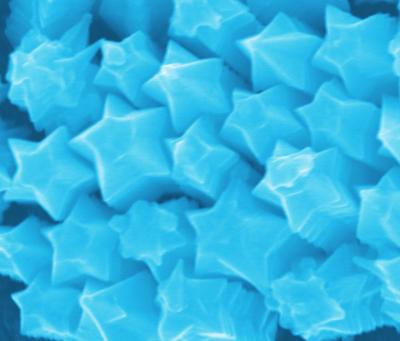Researchers from the Rice University have produced starfruit-shaped gold nanorods, which may support surface-enhanced Raman spectroscopy applications.
 "Gold nanoparticles created by the Rice University lab of Eugene Zubarev take on the shape of starfruit in a chemical bath with silver nitrate, ascorbic acid and gold chloride.Credit: Photo courtesy Zubarev Lab/Rice University"
"Gold nanoparticles created by the Rice University lab of Eugene Zubarev take on the shape of starfruit in a chemical bath with silver nitrate, ascorbic acid and gold chloride.Credit: Photo courtesy Zubarev Lab/Rice University"
An Associate Professor of chemistry, Eugene Zubarev and a graduate student, Leonid Vigderman developed these starfruit-shaped particles using a chemical bath. Earlier in 2008, seed particles containing pure gold nanorods with pentagonal cross-sections were developed. These gold nanorods with pentagonal cross-sections were mixed in a chemical solution containing gold chloride, silver nitrate and ascorbic acid. After 24 h, the particles increased in size of about 55 nm in width and 550 nm in length. When observed under an electron microscope, they looked like star-shaped pillow stacks.
The reason for the change in shape, from pentagons to stars, was unclear. Then, a surfactant, cetyltrimethylammonium bromide (CTAB), was added to the mixture; silver ions in the silver nitrate combined with bromide and resulted in the formation of an insoluble salt, silver bromide.
According to Zubarev, a thin film of silver bromide is deposited on the nanorods' side faces and partly blocks them, which slows down the process of gold deposition. This enables the nanorods to collect more amount of gold at the pentagon's point, wherein they develop into ridges giving a star-shaped appearance to the nanorods, added Zubarev.
When metal ions like nickel, mercury, copper and iron where used instead of silver, they formed smooth nanorods. The metals did not form insoluble bromide salts and this explains the formation of smooth surfaces, quoted Zubarev.
The researchers observed that the starfruit-shaped particles gave back 25 times stronger signals when compared to smooth-surfaced nanorods. This characteristic of the nanorods may allow detection of minute quantities of organic molecules including biomarkers and DNA.
The study has been published online in Langmuir, an American Chemical Society journal.